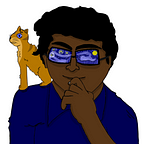An Audition for Existence
Raghu Pratap’s new short is a poignant portrayal of being alone with our thoughts.
The most experimental piece of cinema that I have ever watched is Rhythmus 21, a 1921 3-minute short by an artist named Hans Richter which essentially is a compilation of de stijl set-pieces tuned to a funky drum sequence. The only single-character film I have heard of is Sunil Dutt’s Yaadein. Thus, if I had to set a background while writing about Raghu Pratap’s new movie, titled An Audition for Existence, I would fail miserably. Part of the beauty of the film is that I can still write about it without setting a background.
An Audition begins with a series of unsettling images: a carcass of a bird, a corpse of a human, and a hole in a window; all set to a hauntingly captive score. And then it breaks to silence — followed by a hitman entering the apartment of his latest victim. The next 30 minutes of the movie follow his thoughts as he contemplates the apartment. As he tries to go about his day in the home of his former target. As he makes yet another attempt to live, with himself. The detached monotonous voiceover is a constant reminder that our “hero” who makes a living killing others has been, for long, dead within.
Colored almost entirely in grayscale, the film’s cinematography grants the audience an invasive voyeuristic gaze. The camera finds the hitman in every room he enters, and at points of time it is so close that one pauses to wonder if our hitman is aware of being watched. Perhaps he isn’t because he doesn’t seem to care. Or perhaps he is but he has to pretend that he doesn’t see us watching him, because that’s what he’s supposed to do. It’s an audition, remember?
Dichotomy is central to the film’s essence, right from the title. For instance, the body of the hitman and the voice of his thoughts are played by two different persons. Although Raghu tells me that was a decision more motivated by last-minute convenience and necessity, I do think it’s a good touch to denote the disconnect that exists between our thoughts and what we eventually end up doing. Even the disclaimer about unharmed creatures mentions birds and animals.
Parts of the movie can be an uncomfortable watch. Our hitman’s thoughts lie scattered, we are shown literal corpses right at the beginning, and (especially in the wake of the pandemic) much of the film involves colorless visuals of an existential killer getting by all by himself in a lonely apartment. But Raghu decides to end his film — his longest till now — with color (in what is a magnificent assemblage of some really beautiful images) and a splatter of rains. And perhaps sometimes that’s all we need.
Find Raghu here or here if you’d want to watch the film.
If you like my work, do consider supporting me by buying me a coffee.
